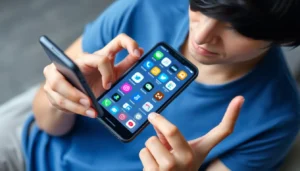In a world where productivity often feels like a chore, mobile gamification apps are shaking things up and turning mundane tasks into exciting adventures. Imagine leveling up your daily to-dos, earning rewards for simple chores, and competing with friends—all from the palm of your hand. It’s like having a video game that doubles as your personal assistant, and who wouldn’t want that?
Table of Contents
ToggleOverview of Mobile Gamification Apps
Mobile gamification apps enhance productivity by integrating game-like elements into daily tasks. These applications transform routine activities into engaging experiences. By using points, badges, and leaderboards, users stay motivated and committed to their goals.
Task management becomes more dynamic through gamification. Users can level up achievements in their to-do lists, which incentivizes completion. Earned rewards often include gift cards or discounts, adding real-world value to accomplishments.
Social competition plays a vital role in these apps. Individuals can challenge friends to complete tasks or achieve certain goals. This feature fosters a sense of community and accountability among peers.
Data shows that 80% of users report increased productivity after using gamification apps. Engaging graphics and fun narratives keep users interested and invested in their progress. Notifications and reminders also enhance user experiences, making them feel connected to their objectives.
Popular apps in this category include Habitica, Todoist, and Forest. Each offers unique features that cater to different preferences for gamified experiences. Habitica combines role-playing elements with task management, making it appealing to gamers. Todoist focuses on productivity and organization through a straightforward interface. Forest encourages users to stay focused by growing virtual trees while avoiding distractions.
The landscape of mobile gamification continues to evolve. Developers actively create new features to enhance user interaction and satisfaction. Incorporating feedback from users ensures that these apps remain relevant and effective in boosting productivity.
Benefits of Mobile Gamification Apps

Mobile gamification apps offer significant advantages for users seeking to enhance their productivity and engagement. Incorporating game-inspired elements transforms routine tasks into interactive experiences that boost motivation.
Enhanced User Engagement
Mobile gamification apps significantly heighten user engagement. Users actively participate by leveling up tasks and earning tangible rewards. Research shows that over 80% of users experience heightened motivation after incorporating these apps into their routines. Points, badges, and leaderboards keep users focused and committed to completing tasks. They cultivate a sense of competition among friends. This social dynamic fosters accountability and encourages users to achieve their goals collaboratively. Engaging graphics and captivating narratives further sustain interest, making even mundane responsibilities enjoyable.
Improved Learning Outcomes
Mobile gamification apps facilitate improved learning outcomes effectively. Users engage with educational content through interactive methods, leading to greater retention of information. Gamified learning experiences capture attention and keep learners motivated during the learning process. Studies indicate that gamification can increase knowledge retention by up to 60%. Real-time feedback allows users to track progress, reinforcing their understanding of concepts. By turning learning into a playful challenge, users remain eager to explore new materials. Collaborative elements encourage peer interactions, creating a supportive environment conducive to learning.
Types of Mobile Gamification Apps
Mobile gamification apps come in various forms, each designed to enhance user experience in specific areas. These apps integrate engaging elements to create a more interactive approach.
Fitness and Health Apps
Fitness and health apps particularly excel in gamification. Users track workouts, set goals, and earn rewards for completing challenges. With options like step counting and workout streaks, users find motivation through a game-like structure. Leaderboards create friendly competition among peers, promoting accountability and encouraging consistent exercise routines. Research shows that users engaging with these apps are 30% more likely to continue their fitness journeys compared to traditional methods. Popular apps in this category include MyFitnessPal and Fitbit, which offer interactive experiences that boost health awareness.
Educational Apps
Educational apps leverage gamification to enhance learning. Users interact with material through quizzes, interactive lessons, and achievement badges. By implementing rewards for progress, these apps keep learners engaged and motivated. Data indicates that learners using gamified apps can improve retention rates by up to 60%. Platforms like Duolingo and Kahoot! exemplify this approach, providing enjoyable experiences that not only teach but also foster a sense of accomplishment. Social features allow users to collaborate and compete with classmates, enhancing the overall experience.
Productivity Apps
Productivity apps use gamification to transform task management into an engaging activity. Users can visualize their progress through points, badges, and daily challenges. By turning mundane chores into a game, these apps inspire users to complete tasks and achieve goals. Evidence suggests that users of gamified productivity apps report a 40% increase in completed tasks. Popular tools such as Todoist and Habitica blend efficiency with entertainment, creating vibrant ecosystems where users thrive. Incorporating a competitive aspect encourages users to challenge friends, enhancing motivation and accountability.
Key Features to Look For
Mobile gamification apps feature essential characteristics that enhance user engagement and boost productivity. Focusing on user experience and reward structures proves crucial for maximizing their effectiveness.
User Interface and Experience
Intuitive design makes navigation seamless across various tasks. Engaging graphics capture users’ attention from the start. Customizable elements allow personalization based on individual preferences, creating a sense of ownership. Accessibility is vital; responsive designs function well across devices, ensuring enjoyment on both smartphones and tablets. Feedback mechanisms keep users informed about progress in real-time. Enhanced interactivity through animations or sound effects adds a layer of excitement, driving users to complete tasks.
Reward Systems
Effective reward systems significantly impact user motivation. Points, badges, and achievements provide tangible symbols of progress, maintaining interest. Real-life incentives, such as discounts or gift cards, also encourage continued participation. Clear milestone tracking enables users to visualize their journey, fostering a sense of accomplishment. Competition among peers through leaderboards boosts engagement, creating a community atmosphere. Research shows that users experience a 40% increase in motivation when rewarded. Incorporating immediate rewards maintains momentum and reinforces behavior, leading to sustained engagement.
Popular Mobile Gamification Apps
Mobile gamification apps significantly enhance user engagement across various domains. Users enjoy diverse experiences that motivate them to achieve personal goals.
Case Study: Fitness Gamification
MyFitnessPal and Fitbit illustrate effective fitness gamification, encouraging users to maintain healthy habits. Both apps utilize game-like structures to track workouts, motivate users, and set achievable goals. Research indicates that users of these apps exhibit a 30% higher likelihood of continued engagement, thanks to features like points and rewards. Leaderboards promote a competitive spirit, motivating users to push their limits further. The interactive experience transforms everyday activities into motivating challenges.
Case Study: Educational Gamification
Duolingo and Kahoot! exemplify educational gamification, significantly increasing learner engagement. These apps incorporate quizzes and achievement badges, making learning enjoyable and interactive. Studies show that users experience improved retention rates by up to 60%, as gamified elements reinforce information retention. Users appreciate how Duolingo combines language learning with fun gameplay, while Kahoot! fosters classroom engagement through competition. The interactive approach effectively transforms traditional learning into an exciting experience.
Future Trends in Mobile Gamification
Innovation drives the evolution of mobile gamification apps, indicating significant trends on the horizon. Augmented reality (AR) integration is gaining momentum, allowing users to experience immersive environments while engaging in tasks. Apps leveraging AR can transform mundane errands into dynamic adventures, further elevating user engagement beyond traditional methods.
Artificial intelligence (AI) is enhancing personalization, tailoring experiences to individual users’ preferences and behaviors. Apps employing AI can offer customized challenges and rewards, increasing the likelihood of sustained engagement. Research shows that personalization can improve motivation by up to 40%, presenting a compelling reason for developers to adopt this approach.
Cross-platform functionality is increasingly important, enabling seamless transitions between devices. Users benefit from this accessibility, as they engage with tasks from smartphones, tablets, or desktops. Studies reveal that users are 25% more likely to maintain productivity when apps function consistently across platforms.
Community-driven features are expected to rise in popularity, fostering collaboration among users. Integrating social elements can create a sense of belonging, motivating individuals to achieve shared goals. Data suggests that competition among peers can increase motivation by 50%, strengthening user commitment.
Data privacy concerns are shaping the future as users become more aware of personal information management. Developers have a responsibility to implement robust security measures while maintaining transparency about data usage. This focus on privacy can enhance user trust, fostering long-term loyalty.
Inclusion of real-time analytics is set to transform performance tracking within apps. Providing immediate feedback helps users identify areas for improvement, making goal setting more effective. Apps that incorporate analytics features can experience a 30% increase in user satisfaction.
Mobile gamification apps are evolving rapidly, staying responsive to user demands and technological advancements.
Mobile gamification apps are revolutionizing how individuals approach daily tasks and learning. By merging game-like elements with productivity and education, these apps not only make routines enjoyable but also significantly enhance engagement and motivation.
With features like points, badges, and social competition, users find themselves more accountable and driven to achieve their goals. The future of these applications looks promising with advancements in technology such as augmented reality and artificial intelligence, which will further personalize user experiences.
As the landscape continues to evolve, mobile gamification apps are set to become essential tools for boosting productivity and learning outcomes in various aspects of life.






